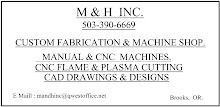Originally, this cab had a mechanical clutch, but the NV4500 has a hydraulic clutch. In the last post, I showed the work involved on the engine side of the firewall to convert this. Here is the interior side. You can see the master cylinder and rod coming through the firewall.
 Here is the end of the rod in relation to the clutch pedal. I will need to fab up a bracket to reach from the pedal arm to the eye on the cylinder rod.
Here is the end of the rod in relation to the clutch pedal. I will need to fab up a bracket to reach from the pedal arm to the eye on the cylinder rod. I started with this bracket. It is a piece that was bolted under the floor to support some of the mechanical clutch linkage. The tab on the left is about the width I need and the angle of the bend seems pretty close to what I need as well.
I started with this bracket. It is a piece that was bolted under the floor to support some of the mechanical clutch linkage. The tab on the left is about the width I need and the angle of the bend seems pretty close to what I need as well. After some creative hacking with my port-a-band and some hammer and vice work, this is what I came up with. The long end with the hole in it will weld to the clutch pedal arm, and the end with my fingers will receive a hole for the pin that will go through the eye in the master cylinder actuator rod.
After some creative hacking with my port-a-band and some hammer and vice work, this is what I came up with. The long end with the hole in it will weld to the clutch pedal arm, and the end with my fingers will receive a hole for the pin that will go through the eye in the master cylinder actuator rod. I noticed that the eye in the rod was hogged out a bit and did not want this to continue if I used a hardened bolt for a pivot pin so I thought about making some sort of bushing. Rummaging around in my brass drawer, I came up with this fitting. I figured I could use it to make a bushing.
I noticed that the eye in the rod was hogged out a bit and did not want this to continue if I used a hardened bolt for a pivot pin so I thought about making some sort of bushing. Rummaging around in my brass drawer, I came up with this fitting. I figured I could use it to make a bushing. I started by drilling out the center with a bit the same size as my bolt. I am thinking it was 1/2 inch, but it may have been 7/16 inch.
I started by drilling out the center with a bit the same size as my bolt. I am thinking it was 1/2 inch, but it may have been 7/16 inch. Nice fit so far.
Nice fit so far. Then, since I do not have a lathe, I chucked the bolt into my drill press. I used a nut on the bolt to keep the brass from spinning on the bolt. Then I used a file and sandpaper to "turn" the brass down...
Then, since I do not have a lathe, I chucked the bolt into my drill press. I used a nut on the bolt to keep the brass from spinning on the bolt. Then I used a file and sandpaper to "turn" the brass down... ...to the right size to fit the eye of the clutch rod. Then, I trimmed it to length to be just wider than the thickness of the eye.
...to the right size to fit the eye of the clutch rod. Then, I trimmed it to length to be just wider than the thickness of the eye. Here the new bracket is clamped to the pedal with a vice grip. I welded a bolt in a hole in the bracket to act as a pin through the rod with the bushing. Then, I double-stacked the nuts to lock it in place while still allowing it to pivot.
Here the new bracket is clamped to the pedal with a vice grip. I welded a bolt in a hole in the bracket to act as a pin through the rod with the bushing. Then, I double-stacked the nuts to lock it in place while still allowing it to pivot.



















 After studying this issue, it looks like I can massage the inner fender around the pipe. I do not think this will get the inner fender too close to the tire. In fact, I really can't see why the inner fender has this lump in it anyway. So, massaging the inner fenders gets added to my to-do list. I assume the left inner fender wil have the same issue.
After studying this issue, it looks like I can massage the inner fender around the pipe. I do not think this will get the inner fender too close to the tire. In fact, I really can't see why the inner fender has this lump in it anyway. So, massaging the inner fenders gets added to my to-do list. I assume the left inner fender wil have the same issue.


